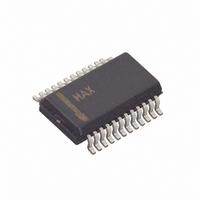MAX8650EEG+ Maxim Integrated Products, MAX8650EEG+ Datasheet - Page 12

MAX8650EEG+
Manufacturer Part Number
MAX8650EEG+
Description
IC CNTRLR STP DWN 24-QSOP
Manufacturer
Maxim Integrated Products
Type
Step-Down (Buck)r
Datasheet
1.MAX8650EEG.pdf
(25 pages)
Specifications of MAX8650EEG+
Internal Switch(s)
No
Synchronous Rectifier
No
Number Of Outputs
1
Voltage - Output
0.7 ~ 5.5 V
Current - Output
25A
Frequency - Switching
200kHz ~ 1.2MHz
Voltage - Input
4.5 ~ 28 V
Operating Temperature
-40°C ~ 85°C
Mounting Type
Surface Mount
Package / Case
24-QSOP
Power - Output
762mW
Output Voltage
0.7 V to 5.5 V
Output Current
25 A
Input Voltage
4.5 V to 28 V
Mounting Style
SMD/SMT
Maximum Operating Temperature
+ 85 C
Minimum Operating Temperature
- 40 C
Lead Free Status / RoHS Status
Lead free / RoHS Compliant
to 20 squares (50 mils to 100 mils wide if the MOSFET
is 1in from the device) for the gate drive. The dead time
at the other edge (DH turning off) also has an adaptive
dead-time circuit operating in a similar manner. For
both edges, there is an additional 20ns fixed dead time
after the adaptive dead time expires.
A flying capacitor boost circuit (Figure 2) generates the
gate-drive voltage for the high-side n-channel MOSFET.
The capacitor between BST and LX is charged from VL
to 6.5V minus the diode forward-voltage drop while the
low-side MOSFET is on. When the low-side MOSFET is
switched off, the stored voltage of the capacitor is
stacked above LX to provide the necessary turn-on
voltage (V
then closes an internal switch between BST and DH to
turn the high-side MOSFET on.
The current-sense circuit amplifies the differential cur-
rent-sense voltage (V
rent-sense signal and the internal slope-compensation
signal are summed (V
PWM comparator’s inverting input. The PWM compara-
tor shuts off the high-side MOSFET when V
exceeds the integrated feedback voltage (V
The differential current sense is also used to provide
peak inductor current limiting. This current limit is more
accurate than the valley current limit, which is mea-
sured across the low-side MOSFET’s on-resistance.
The MAX8650 uses both foldback and peak current
limiting (Figure 5). The valley foldback current limit is
used to reduce power dissipation of external compo-
4.5V to 28V Input Current-Mode Step-Down
Controller with Adjustable Frequency
Figure 2. DH Boost Circuit
12
______________________________________________________________________________________
GS
High-Side Gate-Drive Supply (BST)
) for the high-side MOSFET. The controller
MAX8650
VL
CS+
SUM
Current-Sense Amplifier
BST
- V
) together and fed into the
DH
LX
DL
Current-Limit Circuit
CS-
). This amplified cur-
N
N
COMP
).
SUM
nents, mainly inductor and power MOSFETs, and
upstream power source, when output is severely over-
loaded or short circuited and POK is low. Thus, the cir-
cuit can withstand short-circuit conditions continuously
without causing overheating of any component. The
peak constant-current limit sets the current-limit point
more accurately since it does not have to suffer the wide
variation of the low-side power MOSFET’s on-resistance
due to tolerance and temperature.
The valley current is sensed across the on-resistance of
the low-side MOSFET (V
limit trips when the sensed voltage exceeds the valley
current-limit threshold. The valley current limit recovers
when the sensed voltage drops below the valley current-
limit threshold (except when using the latch-off option).
Set the minimum valley current-limit threshold, when the
output voltage is at the nominal regulated value, higher
than the maximum peak current-limit setting. With this
method, the current-limit point accuracy is controlled by
the peak current limit and is not interfered with by the
wide variation of MOSFET on-resistance. See the Setting
the Current Limit section for how to set these limits.
The MAX8650 can be configured for either an
adjustable valley current-limit threshold with adjustable
foldback ratio, or a fixed valley current limit that latches
the converter off. When latch-off is used (MODE is con-
nected to AVL), set the current-limit threshold by only
one resistor from ILIM2 to GND and make sure this
threshold is higher than the maximum output current
required by at least a 20% margin. Cycle EN or input
power to reset the current-limit latch.
The peak current limit is used to sense the inductor cur-
rent, and is more accurate than the valley current limit
since it does not depend upon the on-resistance of the
low-side MOSFET. The peak current can be measured
across the resistance of the inductor for the highest effi-
ciency, or alternatively, a current-sense resistor can be
used for more accurate current sensing. A resistor con-
nected from ILIM1 to GND sets the peak current-limit
threshold.
For more information on the current limit, see the
Setting the Current Limit section.
The MAX8650 has an adjustable internal oscillator that
can be set to any frequency from 200kHz to 1.2MHz.
To set the switching frequency, connect a resistor from
FSYNC to GND. Calculate the resistor value from the
following equation:
Switching Frequency and Synchronization
PGND
- V
LX
). The valley current











